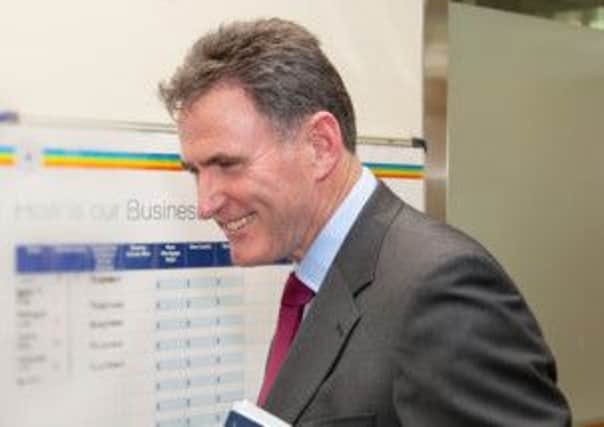Comment: RBS cuts should be the last – for now


The chief executive of Royal Bank of Scotland will unveil his restructuring plans on Thursday with a mixture of optimism that he can realise his dreams, and regret that it means plunging the knife again into a bloated institution. He wants to run the best bank, not the biggest; no longer self-serving for its own aggrandisement, but delivering for its customers.
Project Cook, named after the British explorer Captain James Cook in honour of McEwan’s southern hemisphere roots, will result in the final (we hope) dissection of Fred Goodwin’s global empire, cutting down the last remnants of the investment bank and the withdrawal from at least half the 38 territories in which it still operates.
Advertisement
Hide AdAdvertisement
Hide AdWill it be the final cut? We have been here before. McEwan’s predecessor Stephen Hester told us the “heavy lifting” had been done, that there would be no more big job cuts. No more? Well, just another 30,000 or so. Then we can all move on.
McEwan has told staff the actual number will not be revealed this week, though that is not necessarily a good thing. It means speculation will continue. The good (less bad) news is that 30,000 people will not lose their jobs. About 18,500 will be removed from the RBS payroll when its US bank Citizens is sold or floated and a further 4,000 when Williams & Glyn is offloaded along with its historic apostrophe (apparently because it doesn’t work in a domain name). If the 30,000 figure is accurate it leaves about 8,000 casualties unaccounted for. My understanding is these will come from support staff. Actually, there has not been much new about Project Cook since McEwan announced his review in November.
He admitted there would be a further scaling back of operations and it has been accepted that this would entail job losses and branch closures. The bank announced on Friday a deal to allow customers to do more of their banking in Post Offices, a sure sign that its own network is to be pruned.
So what will be left? RBS will be a shadow of Goodwin’s global monster, shorn of its investment banking prowess and subsidiaries in key markets such as China and the US. Is this a good thing? Hester argued that while it had become too big and out of control it also benefited from scale and from its much-maligned investment bank which accounted for a large chunk of profits.
Hester believed that for the bank to recover properly it could not afford to lose too much and in its desire to placate public outrage over reckless behaviour the Treasury was in danger of cutting off its nose to spite its face. Hester lost the argument and McEwan was brought in to finish the job. And that meant doing as he was told.
His shake-up is hard to contest. The bank will announce a £6 billion loss. Its core tier-one ratio – a measure of the bank’s financial strength – fell last year below 8.4 per cent, just above the minimum required by regulators. It has been heavily criticised over its lending policies and practices. The shares rose on last week’s speculation but still languish 30 per cent below the break even price on the government’s £45bn stake.
If Thursday’s announcement feels like Groundhog Day it will be because there will be a reiteration of all this and another promise of better times ahead. We just have to hope this really does mean the end of the heavy lifting.
Ferrovial well placed to let ambitions fly
THERE were more reports last week about a possible sale of Glasgow and Aberdeen airports, probably to their biggest shareholder, the Spanish infrastructure company Ferrovial.
Advertisement
Hide AdAdvertisement
Hide AdI say more reports because the story first broke in Scotland on Sunday in November (not Sky News as Reuters reported). We disclosed that Ferrovial was in talks with the other shareholders in Heathrow Airport Holdings (HAH) which owns the two Scottish facilities as well as Southampton.
After selling Edinburgh, Gatwick and Stansted it would leave HAH with only its west London hub and perhaps it is no surprise that it has changed its name from BAA to reflect its diminished status.
More to the point, in order finance a proposed third runway at Heathrow it would need to raise capital and it would make sense to do this by selling its remaining assets which would fetch between £800 million and £1bn. Heathrow publishes annual results tomorrow and at the very least we should expect an update on whether the talks with Ferrovial are still on.
Ferrovial’s motives are equally home-driven. Its domestic construction business is suffering the consequences of Spain’s economic crisis and so, like its compatriot Iberdrola – the energy company that owns ScottishPower – it is looking to invest overseas.
It was suggested that Ferrovial will make an offer for the three British regional airports in a joint bid with two Australian funds, but it seems the Spanish firm wants to do this alone.
A further bonus for Ferrovial is that unlike Heathrow, in which it has a 25 per cent stake, the three British regional airports are not subject to price-capping by the Civil Aviation Authority. That would allow it to maximise returns.
Twitter: @TerryMurden1